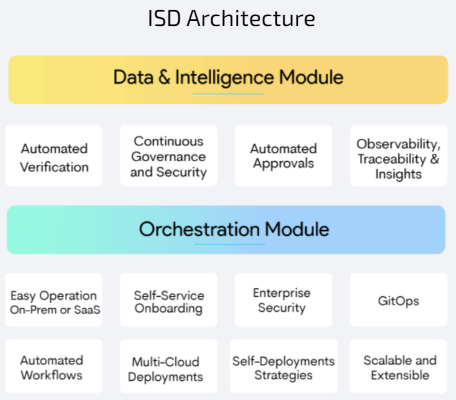ISD Architecture
Architecture
The figure below depicts the component view of the ISD architecture. As mentioned earlier, it consists of two modules, Orchestration, and the Data & Intelligence module.

ISD Services
ISD consists of the following services.
-
Autopilot = Verification service
-
SAPOR = connect with Spinnaker and git/S3 Repo for updating dynamic accounts
-
Visibility = implementation of approval service
-
Dashboard = Collate data for graphical presentation of applications and pipelines
-
OES-Gate = Authentication gateway
-
Sapor-gate = OPTIONAL: spin-gate with basic-auth for Sapor communication
-
Controller = OPTIONAL: remote deployments (Not shown in the Schematic below)
-
OES-UI = Serves the UI elements (Not shown in the Schematic below)
These services also use two databases:
-
OES-db : Postgres DB customized for OES
-
OES-redis : Used by OES-gate
Apart from these, OES includes all the Spinnaker components, configured in HA mode. Spinnaker services functional roles are as follows:
- Deck (GUI)
- Gate (API)
- Clouddriver (Deployments)
- Orca (Orchestrator)
- Echo (Notifications)
- Front50 (DB Frontend)
- Redis (Execution cache)
Key communication paths in the ISD:
-
SAPOR Service communicates with the Spinnaker Gateway and makes API calls to retrieve data, update pipelines, etc.
-
SAPOR can also be configured to use Sapor-gate which uses Basic Authentication. This is useful in cases where Spinnaker is configured with 2-factor authentication.
-
Application is designed based on API-gateway architecture. All data from the web-browser goes through:
- OES-gate or
- Spin-gate
Ingress
ISD requires 5 ingress points:
-
Spinnaker UI : spin-deck service on port 9000
-
Spinnaker Gate: spin-gate service on port 8084
-
OES UI: OES-UI service on port 8080
-
OES gate: OES-API service on port 8084
-
Controller: For an agent to contact the controller, we need an ingress/LB. Note that TLS + gRPC traffic needs to be routed to the controller, shown in red.